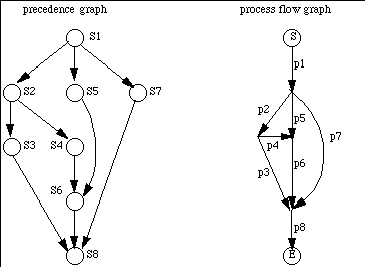
One of the limits on the use of parbegin/parend, and any related constructs, is that the program involved must be properly nested. Not all programs are. For example, consider the program represented by the following graphs.

The program equivalent to these precedence and process flow graphs is:
t6 := 2;
t8 := 3;
S1; fork p2; fork p5; fork p7; quit;
p2: S2; fork p3; fork p4; quit;
p5: S5; join t6, p6; quit;
p7: S7; join t8, p8; quit;
p3: S3; join t8, p8; quit;
p4: S4; join t6, p6; quit;
p6: S6; join t8, p8; quit;
p8: S8; quit
where Si is the program for pi.
To see if this is possible, we must determine if the above program is properly nested. If not, we clearly cannot represent it using parbegin and parend, which require a block structure, and hence proper nesting.
Let S(a,b) represent the serial execution of processes a and b, and P(a,b) the parallel execution of processes a and b. Then a process flow graph is properly nested if it can be described by P, S, and functional composition. For example, the program
parbegin p1:a := b + 1; p2:c := d + 1; parend p3:e := a + c;
would be written as
S(P(p1, p2), p3)
We now prove:
Claim: The example is not properly nested.
Proof: For something to be properly nested, it must be of the form
S(pi, pj) or
P(pi, pj) at the most
interior level.
Clearly the example’s most interior level is not
P(pi, pj)
as there are no constructs of that form in the graph.
In the graph, all serially connected processes pi
and pj have at least 1 more
process pk starting or finishing at the node nij between
pi and pj;
but if S(pi, pj) is in the
innermost level, there can be no such pk (else a more interior P
or S is needed, contradiction). Hence, it is not
S(pi, pj) either.
| You can also obtain a PDF version of this. | Version of April 21, 2008 at 10:53 PM |